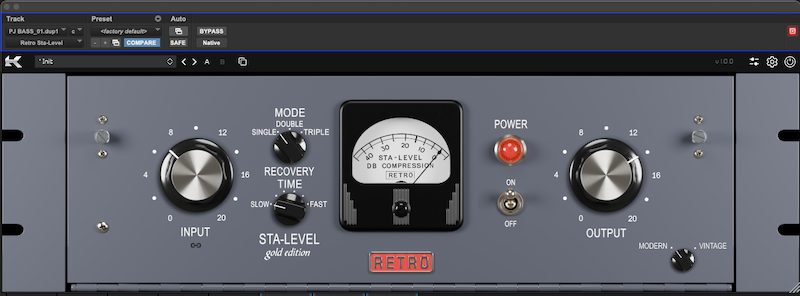 |
| KAZROG Retro Instruments Gold Edition Sta-Level Plug-in |
| Back To The Directory |
KAZROG Retro Instruments Gold Edition Sta-Level Plug-in
By Barry Rudolph
 |
| KAZROG Retro Instruments Gold Edition Sta-Level Plug-in |
The original Gates Sta-Level Compressor is a single channel unit that quickly became a mainstay in AM radio broadcast transmitters in the mid 1950s. In those days, the Sta-Level achieved the big "sonic footprint" for loud, hit radio. By keeping the average audio level higher when modulating the transmitter's carrier signal, the station's coverage area is greatly increased to reach a larger audience.
In conjunction with Retro Instruments' Phil Moore (a former broadcast engineer/technician himself), Kazrog has released a plug-in that models both the Modern and Vintage versions of this classic. Both include the updates and modifications Phil has done to the original hardware units to modernize them for the today's pro audio recording studio. In Modern voicing, you'll have an accurate emulation of Retro Instruments' Gold Edition Sta-Level now celebrating its 50th anniversary.
The Vintage voicing relied on Kazrog's Devin Powers' collections of many vintage Sta-Level units to derive a emulation of the best example of the vintage model. The original units used a 6386 dual triode for the gain reduction section but Phil substituted two 6BA6s wired as triodes that were considerably less expensive.
The vintage units had a fixed release time and only a choice of single and double modes. Phil's mods now included three selectable operating modes named Single, Double, Triple. The three modes are collections of three different, fixed Attack and Recovery time combinations. Recovery was the original name for Release time in those days. Recovery time now has its own six-position switch to fine tune the recovery times built into the selected mode.
Testing
For all my testing in Pro Tools, I duplicated each source (track) and put the Kazrog Sta-Level on one track and my hardware Gold Edition Sta-Level on a hardware insert on the duplicate track. X-OR soloing allowed instantly jumping between them while they played in the mix. During these A/Bs, I was impressed that I could copy the front panel settings from my own Sta-Level Gold to the Kazrog Sta-Level plug-in and get the same processing action and sound. I saw the gain reduction meters worked very similarly.
Operation And More About Modes
Besides the all-tube circuitry, the Sta-Level "sound" starts with compression ratios in a range of 3.3:1 to over 4:1 depending on how much you turn up the Input control; there is no Threshold control. Generally speaking, by turning up the Input control, I was able to do very deep gain reductions--as a much 20 to 30dB on a bass guitar, vocals, and electric guitars and it sounded great with a thick and harmonically colorful tone especially on sustained chords and held out notes.
Single mode has the slowest attack and release settings and is a good starting point for lead vocals and bass guitars. By running up the Input level, gain reductions of up to 25 to 30dB are possible without overload or clipping. On most sources by using a Fast recovery time, you'll achieve a loudness boost and using a slow attack time, will add a hard edge after deep gain reductions recovers. Slower recovery times, where the meter is in constant gain reduction, was perfect for sustaining synth pads or bass guitar.
Double and Triple modes are program-dependent controlled attack and release curves. Double mode is twice as fast as Single. Double mode along with the Recovery control set at three or four dots above Slow ( there are six dots between Slow and Fast) is great for lead vocals with wide dynamics.
I used Modern voicing to put a maximum "cap" on peak levels using up to 20db of gain reduction. Triple mode is faster yet and for the same vocal, a noticeable squash will be heard. Using slow recovery timings and minimal input level will impart an overall thick and warm tone that fills out the sound but does not control peaks.
Acoustic Guitar
I like the Sta-Level for acoustic guitars for keeping a steady and even level to prevent them from jumping out of the mix. Vintage voice, Single Mode, slow, and fast recovery with Gain reductions on the meter were from 5 to a max of 10dB on peaks. For rhythm guitar, I was looking for a big, "center stage" sound for a Martin D28 acoustic; the whole backing track's sound was built around that guitar. Matching knob settings that I normally use on my Sta-Level were remarkable close with differences very subtle, mostly when comparing between the three modes.
Bass Guitar
My "go to" compressor for bass guitar as always been the Retro Sta-Level. I could do gigantic gain reduction--20 to 30dB and it sounded great! I adjusted the recovery time to as fast as possible without distortion. Vintage or Modern voicing with the side-chain filter set to about 350Hz.
Stereo Pads
I tried a stereo instance with Vintage voicing, Single mode, and slow Recovery and around 8 to 12dB of reduction. This setup brought up the pad's chord spread including a sub-octave I never heard before when the pad track was placed within the mix.
Kazrog's Shane McFee and Devin Powers along with Retro Instruments' Phil Moore have preserved the sound and legacy of the classic Sta-Level compressor and now it is available for any DAW.
Available in all Native formats. More information at; KAZROG Retro Instruments Gold Edition Sta-Level Plug-in
Price: $49.99
|
|
|